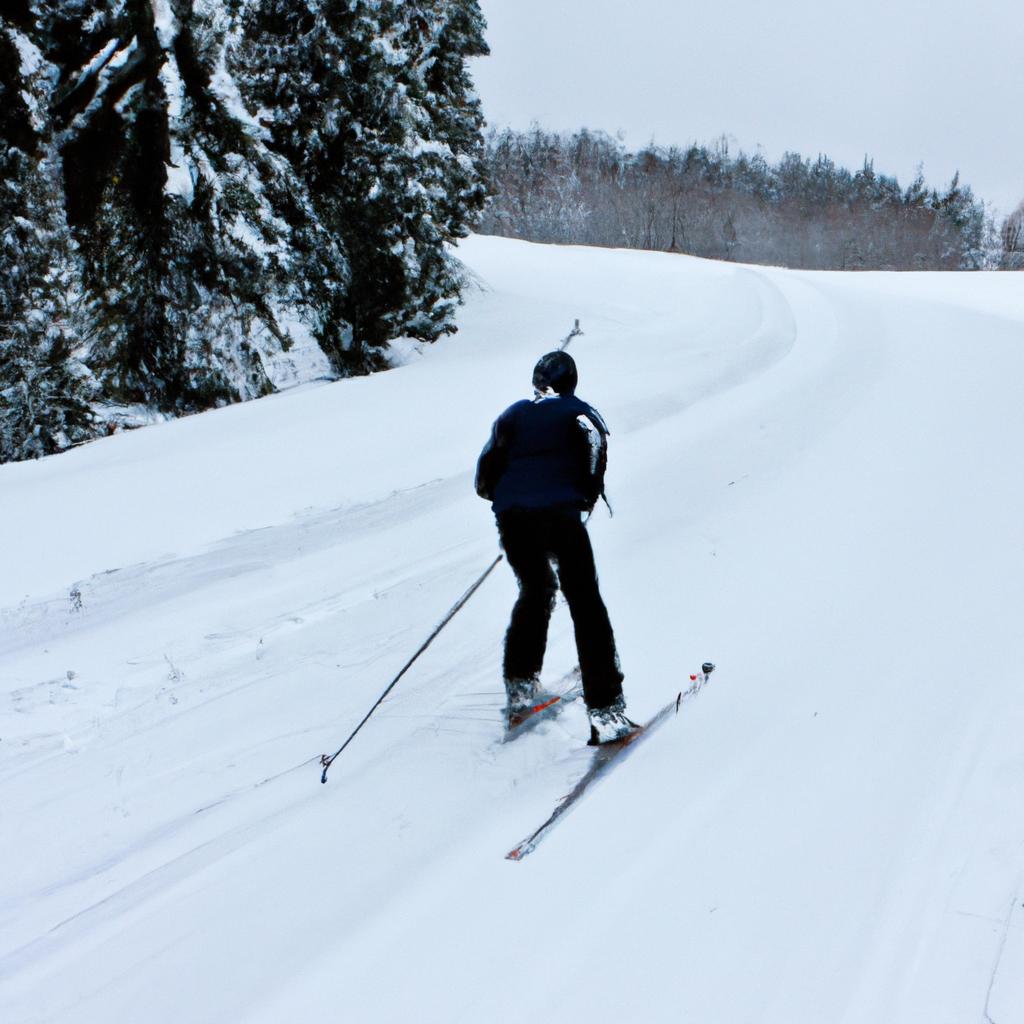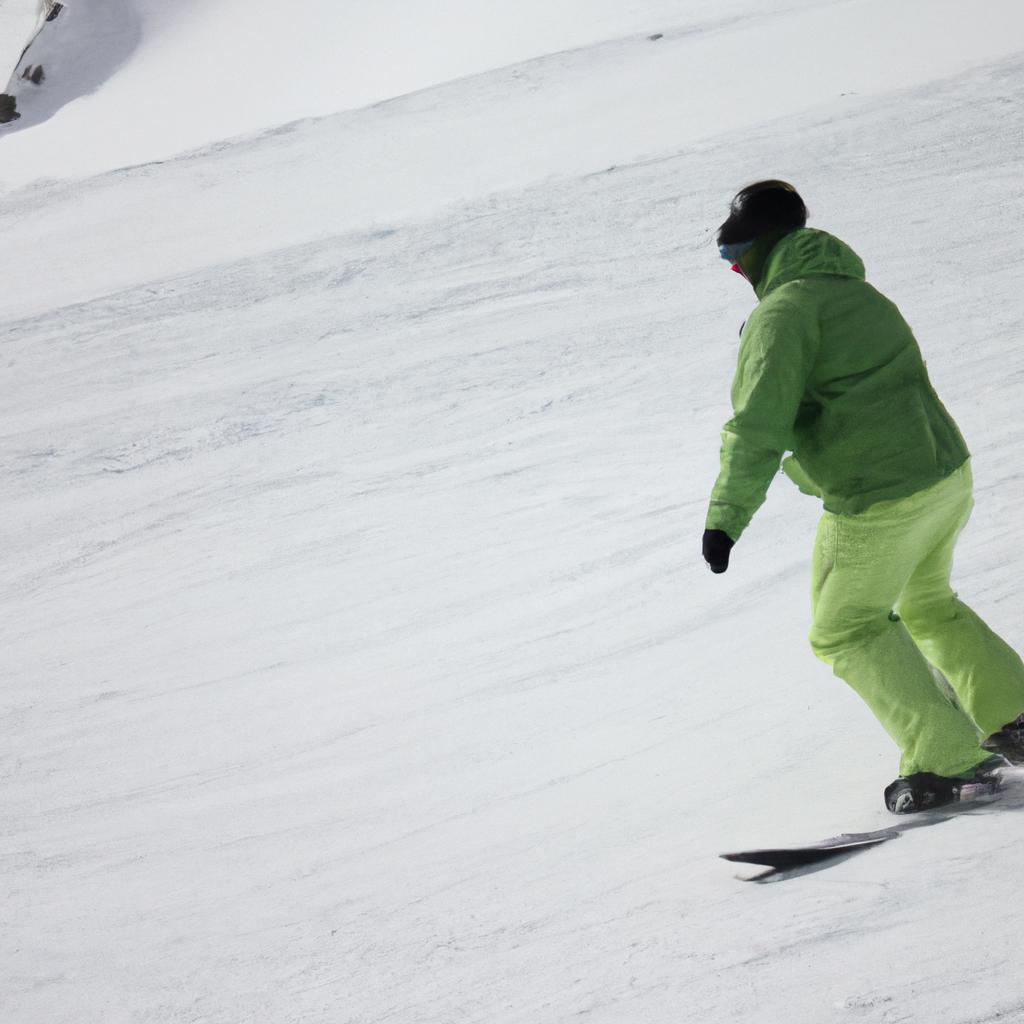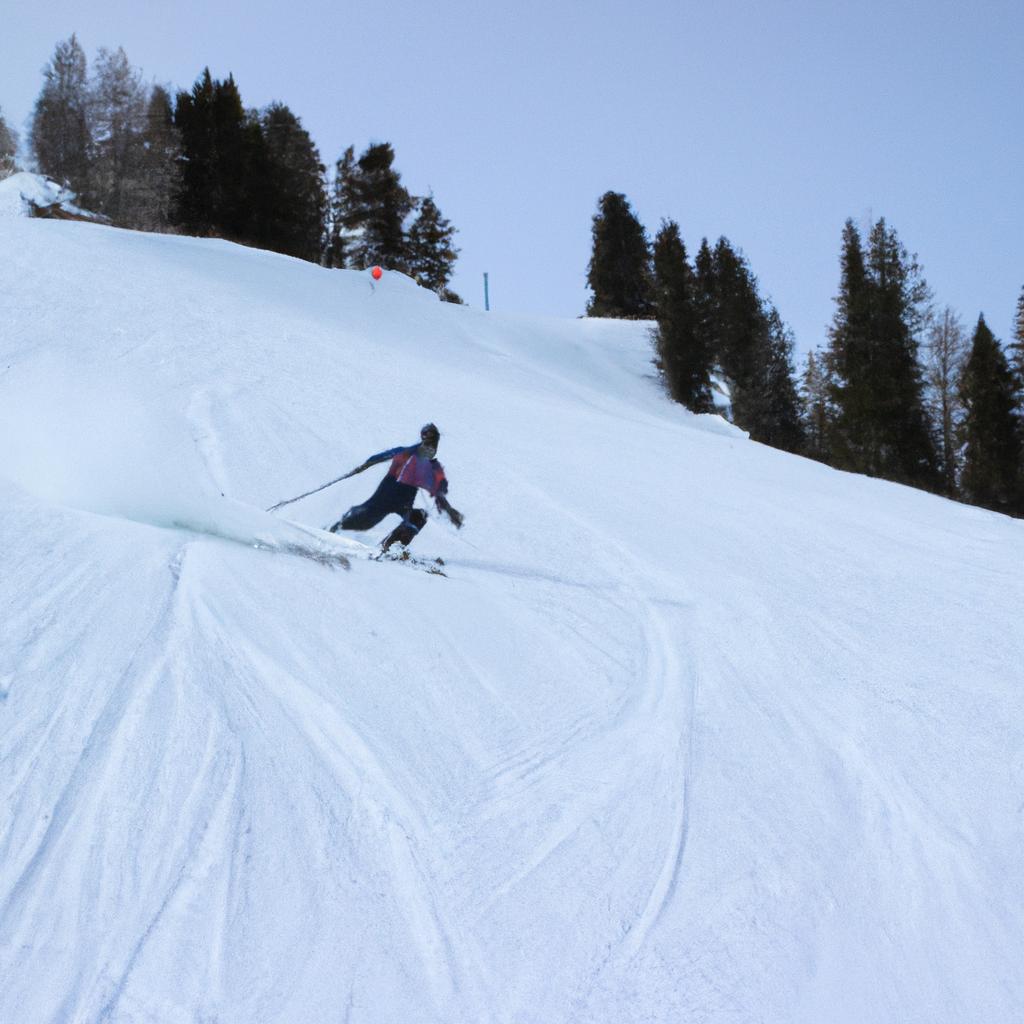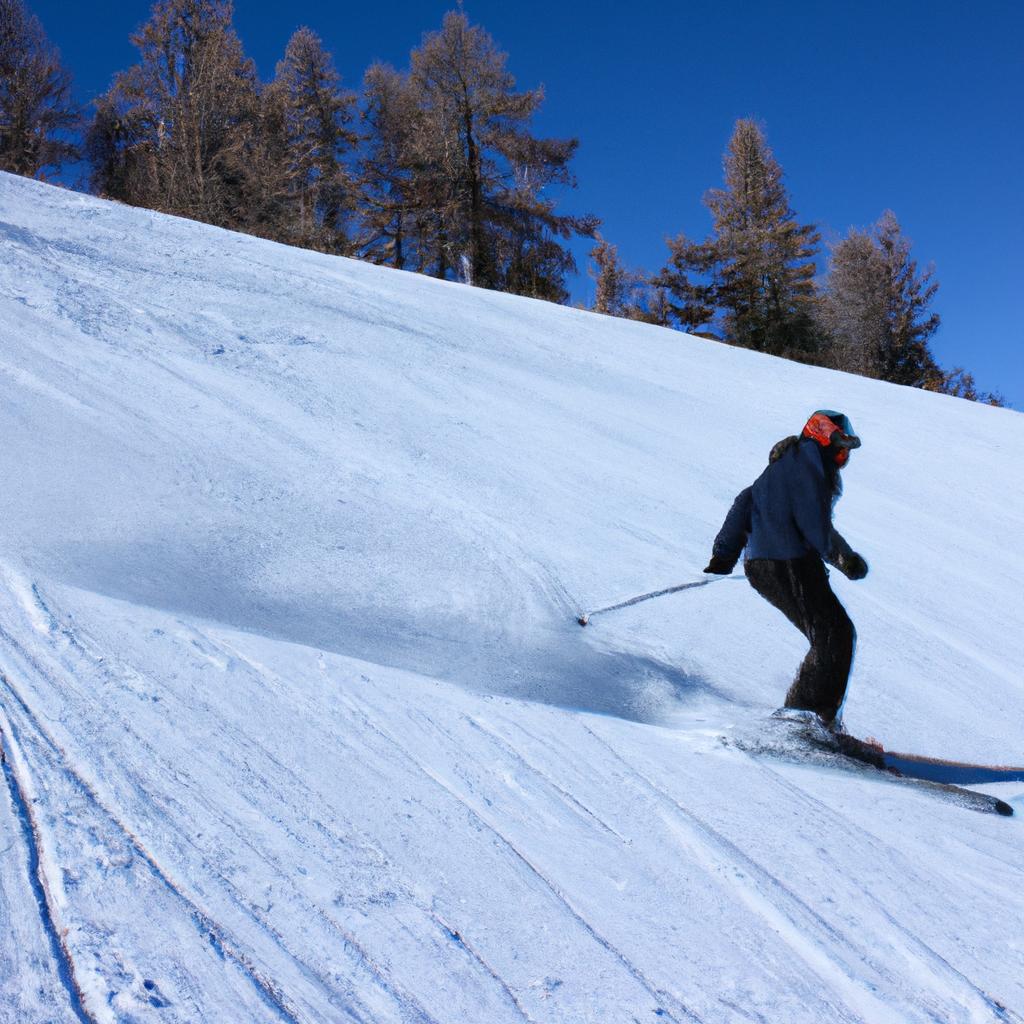Skiing is a popular recreational activity that attracts millions of enthusiasts worldwide. Whether one is a seasoned skier or new to the sport, having the right equipment is crucial for an enjoyable and safe experience on the slopes. This article aims to provide a comprehensive overview of the essential ski equipment needed for travel recreation. To illustrate the importance of proper gear, let us consider the hypothetical case study of John, an inexperienced skier who decided to embark on a skiing trip without adequate equipment.
In this day and age, with advancements in technology and innovation, ski equipment has evolved significantly. The essentials encompass various items that ensure both comfort and safety while engaging in this thrilling winter sport. Skis are undoubtedly at the core of any skiing adventure; they come in different lengths and shapes depending on individual preferences and skill level. Bindings play a vital role as well, connecting boots securely to skis and allowing quick release in case of falls or emergencies. Additionally, boots themselves are specially designed to offer support, flexibility, warmth, and precise control over movements during skiing sessions. Other indispensable pieces include poles for balance and maneuverability along with helmets and goggles for protection against potential hazards such as impact injuries or extreme weather conditions.
The benefits of investing in quality ski equipment cannot be overstated. Not only does it enhance performance and overall enjoyment on the slopes, but it also helps prevent injuries and ensures a safer skiing experience. High-quality skis designed for specific snow conditions and terrain can improve stability, control, and maneuverability, enabling skiers to navigate various slopes with ease. Properly fitted bindings that release when necessary reduce the risk of knee injuries and other accidents caused by awkward falls or tumbles. Well-fitting boots provide comfort and support, allowing for efficient energy transfer from the skier to the skis while offering protection against cold temperatures.
Poles are essential for maintaining balance and rhythm while skiing, especially during turns or traversing flat surfaces. They aid in propelling forward motion and assist in navigating through uneven terrains. Helmets play a crucial role in protecting the head from potential impacts during falls or collisions with objects on the slopes. They greatly reduce the risk of head injuries such as concussions or skull fractures.
Goggles are another must-have item as they shield the eyes from wind, snow, glare, and harmful UV rays. They offer clear vision even in adverse weather conditions like blizzards or heavy fog, ensuring safety while skiing at high speeds.
Investing in proper ski equipment not only enhances performance but also promotes longevity. Well-maintained equipment lasts longer and provides reliable performance over time. It is important to regularly inspect gear for any signs of wear and tear, replacing components as necessary to ensure optimal functionality.
In conclusion, having the right ski equipment is vital for a safe and enjoyable skiing experience. Skis, bindings, boots, poles, helmets, and goggles all contribute to a successful outing on the slopes. Investing in quality gear tailored to one’s individual needs will not only enhance performance but also promote safety while participating in this thrilling winter sport.
Choosing the right skis for your skill level and terrain
Imagine you are a novice skier, eager to hit the slopes for the first time. You’ve taken lessons, practiced some basic techniques, and now it’s time to invest in your own pair of skis. But with so many options available, how do you choose the right ones that will enhance your skiing experience? In this section, we will explore factors to consider when selecting skis based on your skill level and the type of terrain you’ll be conquering.
Firstly, it is crucial to assess your ski ability before making a purchase. Are you a beginner still mastering turns on groomed trails or an advanced skier seeking thrills off-piste? Skiers at different levels have distinct needs when it comes to equipment. For example, beginners often benefit from shorter and more forgiving skis that facilitate control and stability. On the other hand, experienced skiers might opt for longer and stiffer skis that provide greater speed and maneuverability.
Next, identifying the type of terrain you plan to ski is essential in determining which skis are most suitable for you. Consider whether you prefer carving down well-groomed runs or venturing into deep powder fields. Each terrain requires specific characteristics in a ski design. To illustrate this further:
- Powder: Wide-bodied skis with ample rocker (upward curvature) allow better floatation through soft snow.
- Groomers: Narrower waist width combined with camber (slight arch) provides improved edge grip on hard-packed surfaces.
- Moguls: Shorter length with increased flexibility enables quick turns within tight spaces.
- All-Mountain: Versatile skis designed to handle various terrains by combining elements from different specialized categories.
To help visualize these distinctions, refer to the table below showcasing key features of each ski category:
| Ski Type | Waist Width Range | Rocker Profile | Recommended Skill Level |
|---|---|---|---|
| Powder | 100mm+ | Full or Extended | Intermediate to Expert |
| Groomers | 70-90mm | Minimal | Beginner to Advanced |
| Moguls | <80mm | Moderate | Advanced |
| All-Mountain | 80-100mm | Variable | Beginner to Expert |
By considering your skill level and the terrain you plan to ski, selecting the right skis becomes a more informed decision. Remember that these guidelines are general and may vary based on personal preferences. In our subsequent section about essential safety gear—helmets, goggles, and protective clothing—we will further explore how proper equipment plays a vital role in ensuring both enjoyment and safety during skiing adventures.
Essential safety gear: helmets, goggles, and protective clothing
Choosing the right skis for your skill level and terrain is crucial to ensuring an enjoyable skiing experience. In the previous section, we discussed the factors to consider when selecting skis. Now, let’s explore another essential aspect of ski equipment: helmets, goggles, and protective clothing.
Imagine you are a beginner skier who has just started taking lessons at a local ski resort. One day, while practicing on the slopes, you lose control and fall headfirst into a tree. Luckily, wearing a helmet protected your head from any serious injuries. This example highlights the importance of safety gear in minimizing potential risks while engaging in this exhilarating winter sport.
To ensure your safety on the slopes, here are some key pieces of safety gear that every skier should have:
- Helmets: A properly fitting helmet can protect against head injuries during falls or collisions with objects.
- Goggles: These not only shield your eyes from bright sunlight but also offer protection against snow, wind, and debris.
- Protective clothing: Wearing layers of moisture-wicking fabrics helps regulate body temperature and prevents overheating or hypothermia. Additionally, investing in padded pants and jackets provides extra cushioning in case of accidents.
Now let’s take a moment to visualize how these items can enhance your skiing experience:

Table 1 showcases different types of helmets available in the market along with their features and prices. The wide range allows skiers to choose one that fits both their budget and preferences. Remember that it’s essential to prioritize safety over style when making this decision.
| Helmet Type | Features | Price Range |
|---|---|---|
| Full face helmet | Integrated visor | $150 – $300 |
| Half shell helmet | Adjustable ventilation | $80 – $200 |
| Beanies | Soft fabric construction | $20 – $50 |
| Kids helmet | Enhanced head protection | $40 – $100 |
In conclusion, when it comes to skiing, safety should always be a top priority. Investing in helmets, goggles, and protective clothing will not only keep you safe but also enhance your overall experience on the slopes.
[Source: Ski Gear image by Freepik]
Selecting the appropriate ski boots for comfort and performance
Building on the importance of safety gear, let’s now delve into another crucial aspect of skiing – selecting the appropriate ski boots for comfort and performance.
When it comes to choosing ski boots, finding the right fit is paramount. Ill-fitting boots can not only hinder your ability to perform well on the slopes but also lead to discomfort and potential injuries. Consider a hypothetical scenario where an avid skier, Sarah, purchases ill-fitting boots due to their appealing design without paying attention to proper sizing or functionality. As a result, she experiences excruciating foot pain during her first day on the mountain, which forces her to cut short her skiing experience.
To ensure optimal comfort and performance while skiing, here are some key factors you should consider when selecting ski boots:
- Boot Flexibility: The flex rating of ski boots determines their stiffness. A higher flex rating indicates greater rigidity, suitable for advanced skiers seeking enhanced control at high speeds. Conversely, lower flex ratings provide more flexibility and are preferable for beginners or those prioritizing comfort over precision.
- Last Width: The last width refers to the width of the boot’s forefoot area. It is essential to choose a boot with a last width that matches your foot shape properly. Narrow lasts offer a snug fit ideal for narrow feet, whereas wider lasts accommodate wider feet comfortably.
- Liner Material: Ski boot liners play a vital role in providing insulation and cushioning within the boot. Look for liners made from materials such as Thinsulate or Primaloft®, known for their excellent heat retention capabilities and moisture-wicking properties.
- Adjustability Features: Pay attention to additional adjustability features like buckles and straps that allow customization according to your specific needs. These features enable better fit adjustments throughout your skiing journey.
Table Example:
| Factor | Importance |
|---|---|
| Boot Flexibility | Enhances control and precision |
| Last Width | Ensures proper fit |
| Liner Material | Provides insulation |
| Adjustability | Customizes comfort |
Considering these factors will not only contribute to a more enjoyable skiing experience but also ensure the safety of your feet. Now, let’s explore another crucial aspect – understanding the importance of proper ski bindings.
Understanding the importance of proper ski bindings
Transitioning from the previous section on selecting the appropriate ski boots, it is crucial to understand the importance of proper ski bindings. Ski bindings play a vital role in ensuring safety and performance while skiing. Imagine a scenario where an avid skier hits a bump on the slope and loses balance due to faulty bindings. This can lead to serious injuries or accidents. Therefore, it is imperative to comprehend why choosing the right ski bindings is essential.
Firstly, ski bindings serve as the crucial connection between your boots and skis, allowing for effective control and transfer of energy during turns and maneuvers. They are designed with specific release mechanisms that help prevent leg injuries by releasing when excessive force is applied, such as during falls or unexpected twists. For instance, let’s consider a hypothetical situation where a skier experiences a sudden fall due to icy conditions. If their bindings do not release properly, there is an increased risk of knee ligament injuries or fractures.
To ensure optimal performance and safety, here are some key factors to consider when selecting ski bindings:
- DIN Setting: The DIN setting determines how easily your boot releases from the binding. It should be set according to your weight, height, ability level, and skiing style.
- Compatibility: Ensure compatibility between your boots’ sole shape and size with the binding’s toe piece and heel unit.
- Adjustability: Look for bindings that offer adjustable features like forward pressure adjustment or multiple mounting positions to customize them based on your skiing needs.
- Release Mechanism: Assess different binding systems available in the market (e.g., alpine, touring) and choose one that suits your skiing style and terrain preferences.
Emphasizing this further, we can illustrate these considerations through the following table:
| Factors | Importance |
|---|---|
| DIN Setting | Ensures correct release mechanism |
| Compatibility | Enhances stability and power transmission |
| Adjustability | Allows personalized adjustments for optimal performance |
| Release Mechanism | Prevents injuries by releasing during excessive force application |
In conclusion, selecting the appropriate ski bindings is crucial for both safety and performance. By considering factors like DIN setting, compatibility, adjustability, and release mechanism, skiers can ensure a secure connection between their boots and skis. With this understanding of proper ski bindings in place, let’s now transition to exploring another essential component of skiing: the necessity of ski poles and how to choose the right ones.
The necessity of ski poles and how to choose the right ones
Understanding the importance of proper ski bindings is crucial for any skier, as it directly affects their safety and performance on the slopes. Ski bindings are responsible for attaching the boots to the skis, ensuring a secure connection while allowing for easy release in case of falls or accidents. To illustrate this point, let’s consider a hypothetical scenario: imagine a skier who fails to properly adjust their bindings based on their weight and skiing ability. As they descend down a steep slope, their boot unexpectedly pops out of the binding, causing them to lose control and resulting in an injury.
To prevent such incidents from occurring, here are some key factors to consider when choosing ski bindings:
-
DIN setting compatibility: Each pair of ski bindings has a designated range of DIN settings that correspond to different skill levels and body weights. It is essential to select bindings that align with your individual specifications. Failure to do so may result in either premature releases (bindings disengage too easily) or failures to release (bindings remain locked during dangerous situations).
-
Brake width: The brake width refers to the distance between the two sides of the binding where it holds onto the edges of your skis. It should match the waist width of your skis; otherwise, it can cause dragging or accidental tripping if too wide or insufficient grip if too narrow.
-
Release mechanism: A reliable release mechanism is vital for preventing injuries by allowing your boot to detach from the binding under excessive force or twisting motions. Choose bindings with adjustable release values tailored to your skiing style and experience level.
-
Type of skiing: Different types of skiing require specific types of bindings. For example, alpine touring requires “tech” or “pin” bindings that allow uphill mobility by freeing up the heel, whereas downhill skiing necessitates traditional alpine-style bindings that offer greater stability at high speeds.
| Binding Feature | Importance |
|---|---|
| DIN Setting Compatibility | High |
| Brake Width | Medium |
| Release Mechanism | High |
| Type of Skiing Compatibility | Medium |
By understanding these crucial aspects and selecting the appropriate bindings, skiers can significantly enhance their safety on the slopes. In the subsequent section, we will delve into the necessity of ski poles and how to choose the right ones. But before that, let’s explore some essential tips for maintaining and caring for your ski equipment.
Tips for maintaining and caring for your ski equipment
Having covered the importance of choosing the right ski poles, let us now turn our attention to another crucial aspect of skiing – properly maintaining and caring for your ski equipment. By investing time in regular maintenance, you can prolong the lifespan of your gear while ensuring optimal performance on the slopes.
Example:
To illustrate the significance of maintenance, consider a hypothetical scenario where two skiers have identical sets of equipment. Skier A diligently maintains their gear throughout the season, regularly waxing their skis and storing them in a dry environment. On the other hand, Skier B neglects their equipment, leaving it exposed to moisture and failing to address any issues that arise. At the end of the season, Skier A’s gear remains in excellent condition, ready for future adventures. However, Skier B finds themselves facing costly repairs or even having to replace damaged items.
Tips for maintaining and caring for your ski equipment:
-
Cleaning:
- After each day on the slopes, wipe down your skis with a clean cloth to remove snow and ice.
- Use mild soap and water to gently scrub off any dirt or grime that may have accumulated.
- Dry thoroughly before storage to prevent rust or corrosion.
-
Waxing:
- Regularly waxing your skis helps maintain their glide performance by reducing friction.
- Choose an appropriate wax based on temperature conditions; colder temperatures require harder waxes.
- Apply wax evenly along the length of each ski using long strokes and allow it to cool before scraping away excess wax.
-
Edge Maintenance:
- Inspect your edges regularly for burrs or dullness caused by contact with rocks or hard surfaces.
- Use a diamond file or edge tuner tool to smooth out any imperfections and restore sharpness.
- Be cautious when filing not to remove too much material, as this can affect the ski’s performance.
- Proper maintenance enhances safety on the slopes and reduces the risk of equipment failure.
- Regular care ensures your gear remains in optimal condition for a longer duration, saving you money in the long run.
- Well-maintained skis provide better control and maneuverability, enhancing your skiing experience.
- By taking pride in caring for your equipment, you develop a stronger connection with your gear, fostering a sense of appreciation and respect.
Table – Ski Maintenance Checklist:
| Task | Frequency | Importance |
|---|---|---|
| Cleaning | After each use | Essential |
| Waxing | Every 3-5 outings | Highly recommended |
| Edge Maintenance | As needed | Important |
| Binding Inspection & Adjustment | Annually or when experiencing issues | Crucial |
Incorporating these tips into your routine will help ensure that your ski equipment performs optimally while extending its lifespan. Remember to always refer to manufacturer guidelines specific to your gear. By dedicating time to proper maintenance, you can enjoy more memorable experiences on the slopes with confidence and peace of mind.




